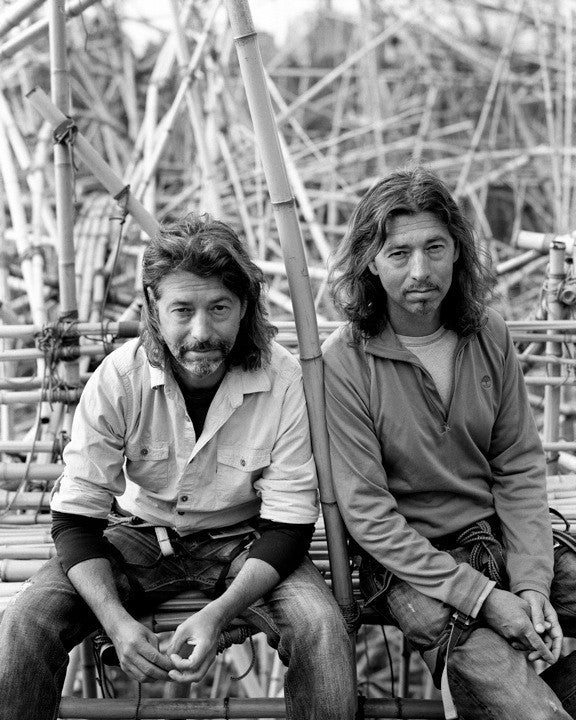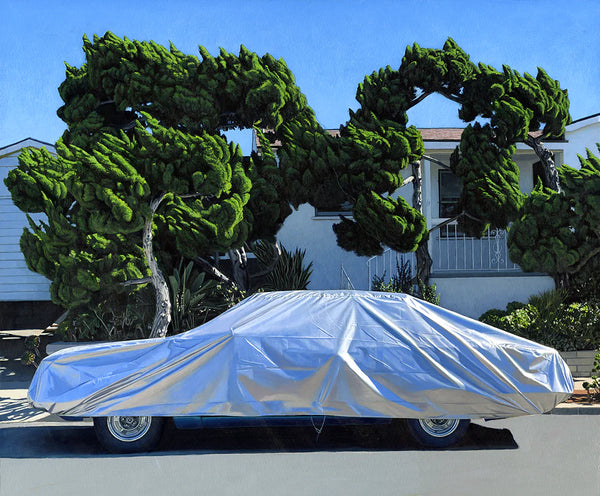This store requires javascript to be enabled for some features to work correctly.

Mike + Doug Starn
Doug and Mike Starn, American artists, identical twins, born 1961. First having received international attention at the 1987 Whitney Biennial, for more than 20 years the Starns were primarily known for working conceptually with photography, and are concerned largely with chaos, interconnection and interdependence. Over the past two and half decades, they have continued to defy categorization, effectively combining traditionally separate disciplines such as photography, sculpture, architecture-most notably their series Big Bambú.
The Starns just completed the installation of (Any) Body Oddly Propped on the plaza of the Princeton Art Museum. The installation is in an overwhelming scale, and like their Big Bambú habitable artworks a sculpture that one walks through. The viewer becomes enveloped by the colors, the light and shadows. The carbon steel framing is a great contrast, while the brothers made expressive use of the old stain glass technique of hand painting with black carbon to create chiaroscuro; the darks have the effect of making the light/color seem more intense. The panels have a rustic character, this is glass that works with its hands for a living…
The 5th institutional installment of Big Bambú took place at the Israel Museum of Jerusalem (inaugurated in June 2014), featuring an outdoor installation with a permanent element titled The Strange Loop You Are, and another one, ephemeral, exhibited over 9 months. Commissioned for Soichiro Fukutake's Naoshima Museum (July 2013-present) for the Setouchi Triennial on the small island of Teshima-Japan-, the forth public installment in the Big Bambú series (titled Big Bambú #8, being the eighth incarnation in the series) utilizes and comprises an entire bamboo forest is created from several hundred living poles in the rhizomatic root of this ecosystem (new poles sprout daily, encroaching the elevated pathway). A beautiful path through the forest ultimately leads to a Bambú walkway tied with climber's cord directly to the living stalks and winds its way up through the forest, higher and higher, until ultimately breaking through the surface of the canopy of bamboo leaves. Only the visitor's upper body emerges and the elevated pathway face the Starns’ vision of a large fishing boat- over 60' long-but made entirely of Bambú - floating on the canopy sea of bamboo leaves at over 60 feet high. The visitors (8 to 10 at a time) approach the boat on the path as if swimming through the canopy, then climb aboard the boat. Entering the cabin of the boat- they descend below deck into the hull to see the interdependent structure creating the being of the boat, a catwalk through the crawl space inside the hull leads them to the bow to the observation bubble which was thought up in a dream actually.
Curated by Francesco Bonami, the first semi-permanent Big Bambú Minotaur Horn Head installation was on view for 3 years, as part of the collection of the Museo MACRO Testaccio, Rome. Over 40 meters tall, a habitable sculpture enveloping up to 60 people within an elevated performance space, double helix stair and labyrinth paths leading up to over 20 meters high to multiple lounging spaces giving views over the banks of the Tiber and Trastevere to Monte Testaccio. In 2011 at the 54th Venice Biennale Big Bambú spiraled over 22 meters high behind the Peggy Guggenheim Collection on the Grand Canal. The acclaimed institutional premiere Big Bambú: You Can’t, You Don’t, and You Won’t Stop, at The Metropolitan Museum of Art in 2010 was the 9th most attended exhibition in the museum’s history with 3,913 visitors per day- with a total of 631,000. Throughout the 6-month exhibit, the Starns and their crew of 12 rock climbers continuously lashed together over 7,000 bamboo poles, a performative architecture of randomly interconnected vectors forming a section of a seascape with a 20-meter cresting wave above Central Park. Big Bambú suggests the complexity and energy of an ever-growing and changing living organism. Several new iterations of the series are being developed internationally.
Gravity of Light, a solo exhibition by the Starn brothers featuring eight monumental photographs illuminated by a single, blindingly bright carbon arc lamp, originally commissioned by the Färgfabriken Kunsthalle, Stockholm, Sweden, took its third incarnation with the Cincinnati Art Museum in the fall of 2012 at a cavernous deconsecrated church and was dovetailed by an eponymous monograph, which offers a comprehensive approach on the artists’ Absorption of Light concept, published by Rizzoli, 2012.
In the spring of 2009, the Starns completed their first permanently installed public commission for the New York City Metropolitan Transit Authority. See it split, see it change, a 250-foot long artwork, up to 14 feet in height, presents the artists’ iconic tree photographs and a leaf transposed into fused glass, marble mosaics and a water jet cut stainless steel fence punctuate the South Ferry subway terminal. It is the recipient of the 2009 Brendan Gill Prize.
At their mammoth laboratory studio in Beacon, New York, the former Tallix foundry, the Starns continue to build the first Big Bambú, a constantly evolving construction, formed by a network of more than 2,500 bamboo poles lashed together. This enormous studio allows Doug and Mike to work in dialogue between Big Bambú and their many concurrent series: most recently The No Mind Not Thinks No Things and other Buddhist explorations- the Absorption of Light concept, alleverythingthatisyou- their photomicrographs of snow crystals, and their re-exploration of the late 19th century color carbon printing process. Through their carbon-prints, the Starns mingle gilding techniques to the painterly photo-process, and further advance their metaphorical lexicon on light with photographs of Buddhist statuary.
Attracted to Light, To Find God, not the Devil’s Insides and alleverythingthatisyou are some of the Starns’ monographic publications. The brothers are currently preparing a new artist book based on their iconic photograph of Ganjin and Big Bambú.
The Starns were represented by Leo Castelli from 1989 until his death in 1999. Their art has been the object of numerous solo and group exhibitions in museums and galleries worldwide. The Starns have received many honors including two National Endowment for the Arts Grants in 1987 and 1995; The International Center for Photography’s Infinity Award for Fine Art Photography in 1992; and, artists in residency at NASA in the mid-nineties. They have received critical acclaim in The New York Times, Dagens Nyheter, Corriere della Sera, Le Figaro, The Times (London), Art in America, and Artforum amongst many other notable media. Major artworks by the Starns are represented in public and private collections including: The Museum of Modern Art (NYC); San Francisco Museum of Modern Art (SF); Solomon R. Guggenheim Museum, (NYC); The Jewish Museum, (NYC); The Metropolitan Museum of Art (NYC); Moderna Museet (Stockholm); The National Gallery of Victoria (Melbourne); Whitney Museum of American Art (NYC); Yokohama Museum of Art (Japan); La Bibliotèque Nationale (Paris); La Maison Européenne de la Photographie (Paris); Los Angeles County Museum of Art, amongst many others.
Join our mailing list for 15% off
Sign up for our newsletter to get first access to new editions, catch the freshest commentary + features, and snag a special discount.




